Facebook Engagement and Its Relation to Visuals,With a Focus on Brand Culture
Yagodina Kartunova
New Bulgarian University, Bulgaria
Facebook Engagement and Its Relation to Visuals,With a Focus on Brand Culture
Yagodina Kartunova
New Bulgarian University, Bulgaria
Facebook has changed the way customers interact with brands and their expectations toward corporate communication. Creating brand stories has always been one of the most powerful marketing tools, but in digital media the story is fragmented; it is distributed through different media platforms (social media, corporate websites, blogs, etc.) and comes in different forms—images, video, text. As the news feed is constantly changing and overloaded with information, customers tend to pay more attention to messages which are relevant, easy to understand with clear visual representation, and which are valuable enough to be shared. That is why images are an essential part of online corporate communication, and communication experts use semiotic approaches to analyse the visual language of their brand and to create a digital brand mythology.
digital media, social media, Facebook, brand culture, brand mythology
1. Introduction
As of August 2017, Facebook had 1,280 billion daily active users (Socialbakers, 2017),making the social network one of the most important marketing assets for companies.Its main goal is to connect people all around the globe, but it has also given brands the unique opportunity to become an integral part of their customers’ daily life by creating and developing a brand page. The fans of brand pages spend up to 5 times more on that brand’s products in comparison to users who are not fans of the page (Hollis,2011). By clicking on the Like button, the user becomes a fan of the brand and starts seeing its posts in his news feed, if the Facebook algorithm decides that the content is relevant. The Facebook brand page is an official virtual space where the company has the opportunity to tell its story, to present its culture and to influence the customers’behavior. In recent years the effectiveness of brand pages is measured by the fans’engagement, as the ultimate goal of every company is to build a relationship with the target audience and to create brand ambassadors who are loyal to the brand. That is why one of the main challenges for the companies is to create engaging content. The easy process of publishing content on Facebook and creating ads has made it almost automatic. All the data, provided by the team of Mark Zuckerberg, is extremely valuable but communication experts need to combine the numbers with a deeper understanding of the users’ behavior and explore different ways of creating meaning for him. Visual publications are one of the most commonly used ways of conveying brand messages in Facebook. Berger describes the images as “a set of characters and symbols” (Asa Berger, 2012, p. 67). As consumers see thousands of images from both their friends and the brands, which they have liked, companies must create visuals which not only attract the customers’ attention but motivate them to react to it by liking, commenting on, or sharing it. One way of achieving this ambitious goal is to tell the brand story in an engaging way by presenting its cultural elements—values, rituals, heroes, and symbols.
2. Theoretical Framework
2.1 Brand culture
According to Hofstede (2010), culture is a software which significantly influences the way individuals think, feel, and behave. “Culture consists of the unwritten rules of the social game. It is the collective programming of the mind that distinguishes the members of one group or category of people from others” (Hofstede et al., 2010, p. 6). Different cultures share the same manifestations—values, rituals, heroes, and symbols. This is the so-called cultural onion, proposed by Hofstede, which reflects the different layers of culture. Symbols are brand elements that evoke certain meanings, recognized by the users.The heroes are characters with personal traits that are highly valued by the customers and are seen by them as role models. Rituals are collective activities with symbolic meaning.The values are at the culture’s core. “Values are broad tendencies to prefer certain states of affairs over others” (Hofstede et al., 2010, p. 9). The external manifestation of all these cultural elements are the practices, shared by the company and the customer. We cannot study culture separately from the individual—it is not a set of abstract rules, as it influences the way he creates and interprets meaning. That is why we can assume that if brands incorporate cultural elements into their communication strategy, they will be able to create images which are meaningful, and increase the customers’ engagement.
The anthropologist Grant McCracken (1986) recognizes four types of consumer rituals which can be also performed in the virtual space:
- exchange rituals: in social media the customers can send their friends almost everything—flowers, cakes, greetings, etc. “Gift exchange allows individuals to insinuate certain symbolic properties into the lives of a gift recipient and to initiate possible meaning transfer” (McCracken, 1986, p. 78);
- possession rituals: in Facebook users can show their product possession just in few clicks,demonstrating their lifestyle, values, etc.;
- grooming rituals: posting so-called “selfies” is one of the main trends on Facebook and brands can successfully become part of it;
- divestment: this is a more personal ritual and it is not commonly used by brands.
Besides involving the customers in a ritual performance, another way of influencing the customers’ behavior is by creating habits. Given the trend that individuals are looking more and more for convenient solutions to save time and effort, the importance of customer habits for corporate communication increases. In the nineteenth century,William James studied how the individual’s behavioral patterns shape his personality. He describes the habit as one of the most essential elements of society—“its most precious conservative agent” (James, 1890, p. 349). In the context of corporate communication, it is important to note that the creation of new habits demands two elements—strong stimuli and excitement. The American semiotician Charles Sanders Peirce also sees habit as an integral part of the mind—it is a rule for action that saves mental energy which the individual can use for more important cognitive tasks. He believes that through habit(mental or physical), the individual thinks and reacts to signs. Charles Duhigg (2012),who won a Pulitzer for his bookThe Power of Habit, describes the process of creating a habit: first there is the sign—it evokes the respective habit in the mind, then it performs the routine actions, and at the end the reward helps the mind to remember this process,which becomes automatic with time. In order to create a customer habit, the company needs to use a recognizable sign with clear meaning which the individuals will associate with the desired prize. The company can either use the existing customers’ habits and associate them with its product, or create new ones. For example, most customers are accustomed to checking their Facebook newsfeed, which makes social media a favorable environment for the creation of a habit. The companies can achieve this by taking advantage of actions that are routinely performed by the target audience:
- posting a message with identical structure and similar content that asks for a clear action on a fixed day or time. For example, Eucerin Bulgaria announces a game every Tuesday at eleven o’clock. This way the customer knows when and where to look for relevant information in order to receive the reward;
- presenting the product as part of a consumer consumption ritual;
- posting a link: sharing interesting and valuable information which refers to the corporate website. Creating the habit of visiting the website for more information is one of the most valuable goals it can achieve;
- regularly posting images which present the product as part of the ideal lifestyle of the customer: it links the brand with the dream;
- creating events with the same theme or purpose. Durkheim says that the shared emotion stimulates confidence and courage to act. It makes the individual feel that he does the right thing (Collins, 2005, p. 39), etc.
The predictions are that in the coming years most of the users’ searches and some of the actions (like shopping) will be performed with the help of virtual assistants (Google Home, Alexa, etc). This will lead to automation of some of the customers’ tasks, and the ability to build relationships and create habits will be essential for the companies’development. One of the main elements in this process is the brand story, its recognition and adoption by the target audience, and the rituals by which they experience the story.
2.2 Brand story
One of the main marketing tools for customer engagement is telling the brand story. This is a semiotic object which is created and developed through text (Marrone, 2003). Its first goal is to attract the customers’ attention in the news feed, to evoke positive feelings and emotional reaction, and to motivate a desirable action—comments, website visits, etc. The second goal is to build a relationship with the customer and to create a habit (for example, to share the personal results from the Nike+Run application). Roland Barthes asserts that the narrative is as old as humankind, and is part of all social practices (Barthes, 1977,p. 79). It is one of the ways to give meaning to the world (Fiske, 1987, p. 128), because human memory is based on stories (Shank 1999, p. 12). Greimas asserts that there are three elements of a great story (Foggia et al., 2009, p. 427):
- brand values: they are the core;
- the plot;
- the discourse: it includes all the elements which convey the story meaning.
The brands that have become icons not only tell their story—they create a myth.Legendary brands connect with their customers through sacred beliefs—a special set of mental constructs which help the customer to make sense of the world (Vincent, 2002,p. 20). They define who we are, what our values are, what our ideal lifestyle is, etc.They are based on the understanding that individuals look for meaning in the world, and that everything that cannot be explained logically evokes frustration and insecurity. In contemporary life, myth recognition helps the customers to find meaning and to make their choices despite the abundance of products and information. The narrative is the connection between the sacred beliefs and the world and it is maintained through brand rituals and symbols. They help the customer to take the brand as part of his culture and identity. The company can achieve this by (Vincent, 2002, p. 36):
- creating brand communities: the myth is a story told by a collective voice and shared point of view;
- performing rituals: they have an important role in conveying the meaning;
- using symbols: they remind the customer about the brand narrative (for example, the American Express card is a symbol of the financial status of its owner).
In Facebook, besides telling the brand story, companies need to motivate users to develop and use the brand as part of their personal story (by commenting, sharing,posting, etc.).
An important element of every myth is the archetypes. Jung describes them as “forms or images of a collective nature which occur particularly all over the earth as constituents of myths at the same time as individual products of unconscious origin” (Mark & Pearson, 2001, p. 4). The marketing expert Margaret Mark and the psychologist Carol Pearson create a typology of the brand archetypes which can help companies to create strong myths on Facebook. The archetypes and their primary function in people’s lives are (ibid, p.13):
- creator: crafts something new;
- caregiver: cares for others;
- ruler: exerts control;
- jester: has a good time;
- regular guy: ok just as they are;
- lover: finds and gives love;
- hero: acts courageously;
- outlaw: breaks the rules;
- magician: affects transformation;
- innocent: retains or renews faith;
- explorer: maintains independence;
- sage: understands the world.
These archetypes are related to the individuals’ behavioral motivation. The four major human motivations are positioned along two axes: Belonging/People versus Independence/Self-actualization, and Stability/Control versus Risk/Mastery (ibid, p.14). The experts believe that most people seek to belong to a group, but at the same time they want to express their individuality. They want to have control and stability but they also get excited by the unknown. The largest global social media study, conducted by UM in 75 countries over 8 years, reveals the basic customer’s needs and their behavioral motivations. It finds out that people look for (UM, 2014):
- knowledge: the need for up-to-date, personalized information motivates people to check their Facebook several times a day;
- entertainment: one of the most common needs that customers seek to satisfy. 40% of the respondents say that if the brand is entertaining, it becomes more attractive;
- recognition: the main reason for brand loyalty. 65% said that if they have complained on the brand page and have received the brand’s attention, it makes them feel important;
- progress: a basic need which motivates the customer to spend more time with the brand.37% want the brand to help them improve their professional or personal skills;
- relationships: the main reason why customers recommend a brand.
The study shows one interesting result: the combination of recognition and knowledge has the greatest impact on sales. Identifying the customer’s motivation and choosing a relevant brand archetype help companies create an effective communication strategy.Based on the work of Mark and Pearson and the results of the UM study, we can identify the most engaging content for each archetype:
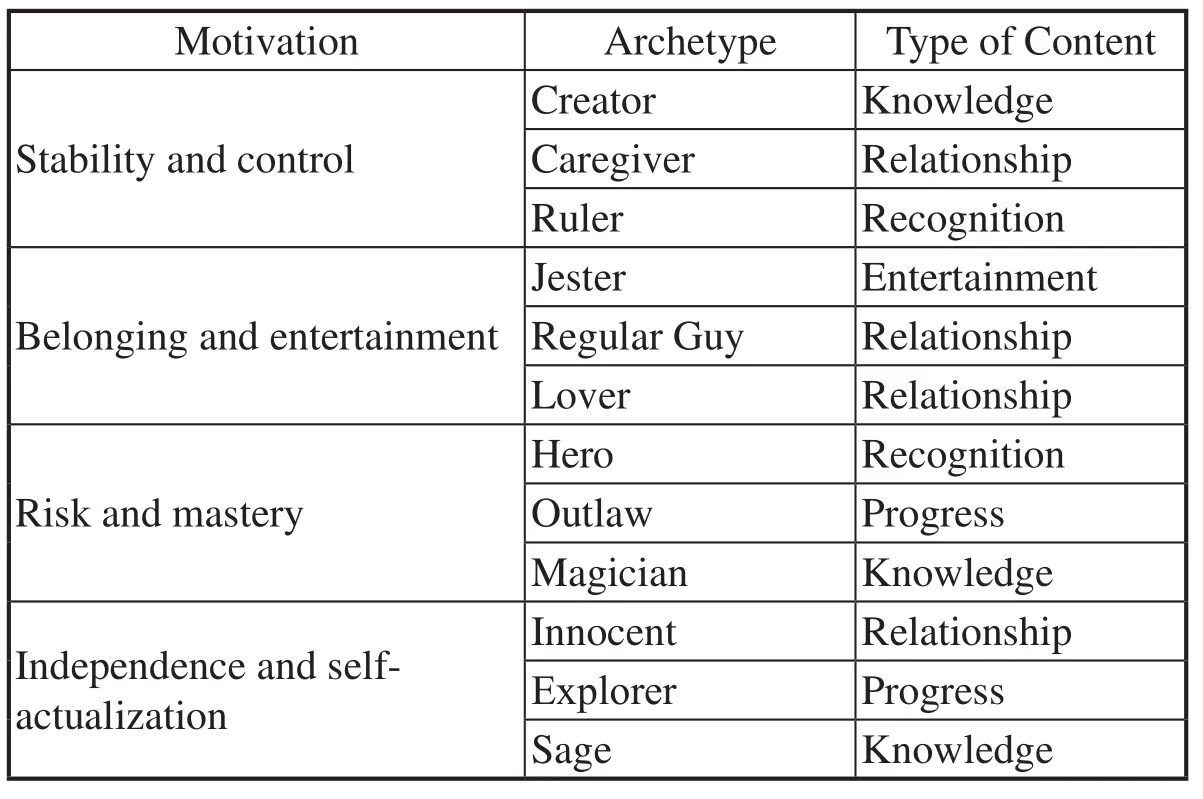
?
The customer recognizes unconsciously the archetype used in the brand myth, and if the content meets his needs, he experiences it through his personal digital story. This way the company influences his behavioral pattern and succeeds in engaging him, which is its main goal, as mentioned beforehand.
2.3 Customer engagement
Customer engagement is defined as a “psychological state that occurs by virtue of interactive, cocreative customer experiences with a focal agent/object (e.g., a brand) in focal service relationships” (Brodie et al., 2011, p. 260). It can lead to customer recommendation, proactive behavior, spread of awareness through word of mouth, and purchase (van Doorn et al., 2010), as well as repeat purchases and loyalty (Verhoef et al.,2010). Customer engagement can create different values for the brand (Kumar et al., 2010):
- product purchase;
- recommendation;
- influencing other customers;
- feedback.
Several research companies also have conducted studies on customer engagement.They have given it the additional definition as the emotional bond between the company and the target audience, which has a serious impact on customer behavior (Gallup, 2014).The same survey identifies three types of customers—fully engaged, neutral, and actively unengaged, based on their answers to three statements:
- the company always delivers what it promises;
- I am proud to be a customer of this company;
- the brand is ideal for people like me.
The company needs to focus on meeting the customers’ expectations, to create an emotional bond with the target audience, and to consider their social need to belong to a group of people with similar interests. That is why Facebook is one of the most efficient communication channels to connect with the customers (SAP, 2013). It is not only important to reach them and inspire one-time actions; companies need to engage them with valuable content on a regular basis (Pulizzi, 2012).
On Facebook, engaged customers’ actions create different values for the brand. For example, content which is shared by other individuals has a more positive impact on sales than information published by the company (Godes & Mayzlin, 2009). As Bankov (2014)has noted, individuals perform various consumer rituals on social networks:
- follow the brand page;
- like the brand page;
- participate in a group with other brand fans;
- publish information from a brand application;
- react to a post;
- comment on a post;
- share a post;
- post on the brand page or rate the brand;
- mention the brand in a personal post;
- share a picture of/with the brand;
- use a picture of/with the brand as a cover photo;
- link the relationship status with the brand;
- use the brand name as a personal name;
- use a picture of/with the brand as a personal profile picture.
The first two show that the individual is interested in the brand but it does not mean that he wants to be identified with its story. Participating in a brand group indicates that the individual likes the brand. By sharing information from the brand’s app he demonstrates identification with the brand values. Reacting to, commenting on, and sharing brand posts are different types of interactions which show the customer’s brand perception and serve as a sign to others. Reactions show the lowest engagement level because they do not give much information about the customer’s experience and emotions. Sharing indicates the highest level of engagement because the brand story becomes part of the individual’s personal story, as presented in his profile. The next three actions are related to the creation of personal posts with the brand and they indicate a higher engagement level. The last four actions are the most valuable for the brand because they are performed by people who are emotionally connected with the brand and are its loyal ambassadors.
Despite all the studies of customer engagement, there are some gaps, mainly related to the study of the impact that the brand’s cultural elements (values, rituals, heroes, and symbols) have on the users’ engagement behavior (reactions, shares, and comments).In the next section I will present the content analysis of two brands of spirits with the largest audience on Facebook—Johnnie Walker and Jack Daniel’s Tennessee Whiskey(Socialbakers, 2017).
2.4 Visual semiotics
In order to build and develop their brand story and to increase the customers’ engagement,brands need strong visual language. The French semiotician Roland Barthes is one of the first to study visual rhetoric by basing his research on the ideas of Ferdinand de Saussure.A major part of his work is dedicated to the theory of connotation and denotation (the different layers of meaning) and the role of the myth. The media texts (such as Facebook posts, for example) represent two layers of meaning—denotative (the literal meaning encoded to a signifier) and connotative (the context-dependent second level of meaning, created by the community). Myths are described by Barthes as signs which communicate social, cultural, political, and other meanings. Their study is part of the general study of signs, which was developed by Saussure (Barthes, 1973, p. 111). The first step in this process is to identify all the elements of the image—textual and visual. During this step, the researcher indicates the denotative level of meaning. Afterwards, he needs to analyze every element in order to be able to reveal the connotative meaning and to identify the cultural elements which have been used (Bauer & Gaskell, 2007, pp. 232-237). The online communications professor Arthur Asa Berger (2012) believes that the perception of the visual content depends on several main perspectives—historical, cultural, social,and individual. These elements are the lenses through which the customers interpret the images. That is why, for the image analysis, the researcher needs to take into consideration the author, the target audience, the image itself, the society to which the individuals belong, and the medium. In order to create meaningful and clear messages, brands need to use all the types of signs described by Pierce (Berger, 2012, p. 52):
- icons: there is resemblance between the signifier and the signified;
- indexical signs which invoke certain logical meanings in the customer;
- symbols with a meaning which has been negotiated and accepted by the society.
Another idea of Pierce’s with great value for visual semiotics is the interpretant theory,because under this theory images can evoke different interpretations in individuals’ minds.The interpretant, created by the sign, is shaped also by the beliefs, desires, and habits of the interpreter. All brands create visual elements which aim to create an interpretant related to the habit of consuming the product (Nöth, 2011, pp. 312-313).
Two scholars who contribute to the development of visual semiotics are Gunther Kress and Theo Van Leeuwen. They develop the concept of multimodality, where several modes are combined to create meaning. Everything from the choice of the modes to the organization and placement of the images creates meaning. The researcher should take into consideration the framing—how the elements are connected or disconnected in the context of the image. The creation of meaning depends also on the presentation of the visualization—if the elements are close or at a distance, if they are at the center or at the margins, if they are positioned on the top or at the bottom. If there is a person in the image, it usually attracts the attention of the viewer and its representation is very important too. If there is eye contact, a connection is established. These kinds of images are called demanding because symbolically they motivate expectations related to the customers’ behavior (to buy the product, to call the company, to visit the corporate website, etc.). The gestures and the facial expression clarify what the user is expected to do. If there is no such contact, the individual interprets the image differently, in a more distant way. These visuals are more like offerings. Van Leeuwen and Jewitt offer a scheme which illustrates the meaning potential of the perspective:
The meaning potential of the perspective (van Leeuwen & Jewitt, 2000, p. 136)
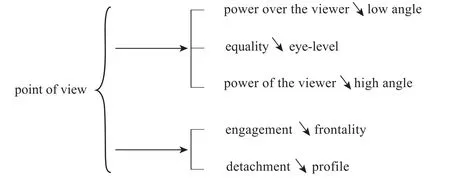
The perspective and the understanding that the viewpoint could be used to convey different meanings has its roots in the Renaissance. Before then, images presented only the authors’ point of view, but as the focus moved to the individual, his needs,and freedom of mind, the authors started taking into consideration the various ways of creating the message and its possible interpretations. Kress and Van Leeuwen state that the meaning depends heavily on the composition—which elements are at the front, the color of the background, the size of the elements, etc. For example, Coca-Cola often posts on its Facebook page images with peoples’ faces. This way the customer can feel their love, joy, and happiness, and feels engaged. On the other hand, the accounting company KPMG posts people who are at a distance, moreover we often do not see their faces. This way the images imply that they are experts, they have more professional experience than the viewer, and he cannot identify himself with them. Kress further suggests a scheme which represents the value and meaning of every element based on its position:
The position of the visual elements and their meaning (Kress & van Leeuwen, 1996)
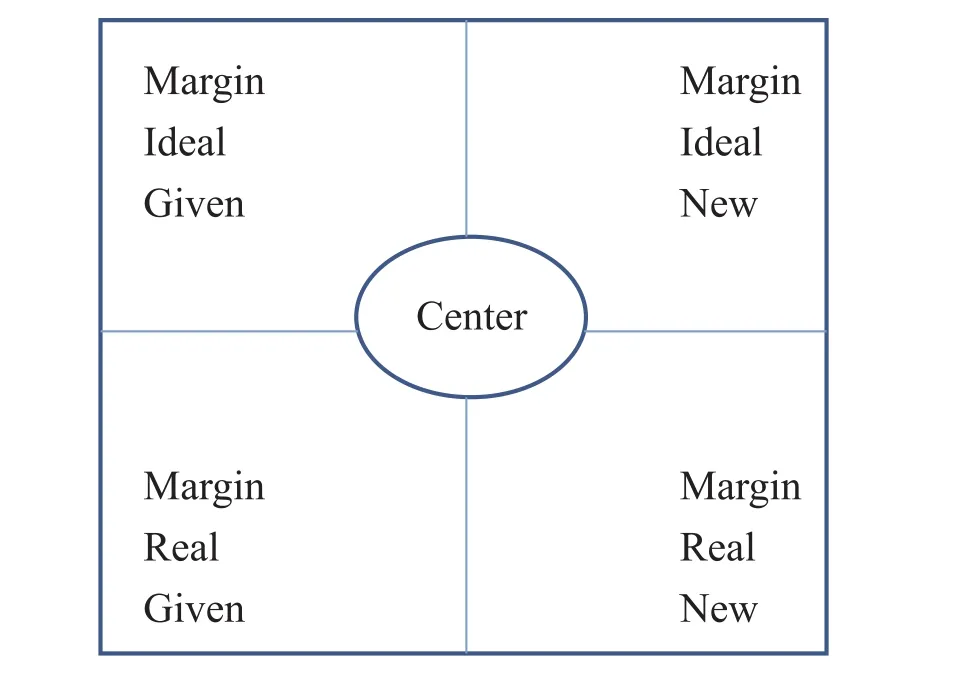
The main distinction is between the ideal, which is at the top of the image, and the real, which is at the bottom. The real can be perceived as “here and now”, the known facts, the details, and practical information. On the other hand, the ideal is related to desire, dreams, the future, the unknown. The presentation of the ideal should inspire the target audience to buy the product in order to make their dreams come true. The alreadyknown information is positioned at the left, while the new is at the right. The center is the focal point which brings all elements into one meaningful message (Kress & Van Leeuwen, 1996, p. 187). In their research, the two scholars use as a theoretical background the studies of English linguist Michael Halliday. He defines three semiotic processes which he calls metafunctions: the interpersonal function (the role of language to create a relationship between the designer of the message and the viewer), the ideational (related to the creation of the image), and the textual (it connects the individual perceptions with existing texts). Kress and Van Leeuwen develop the study of Halliday in order to be applicable to the research of visuals. All semiotic modes serve three metafunctions in order to function as a full system of communication (Kress & Van Leeuwen, 1996, p.40). The two scholars believe that every image not only represents the world but also communicates interaction, no matter if there is a textual call to action. The main sequence of the visual analysis, proposed by Kress and Van Leeuwen, is: study the elements, then the representation mode, the participants, and the composition of every element and its relation to the viewer (Van Leewuen & Jewitt, 2000, p. 138).
3. Research
“Advertising is nothing less than a ‘conduit’ for transferring meanings from the world of culture to the world of consumer goods. Advertising plays a role in creating consumer culture and influencing the ways consumers interpret the marketplace, adopt consumption rituals, and even form identities” (Oswald, 2012, p. 6). Brand content published on Facebook is not advertising, but its main goal is to influence the customer’s perception of the product, to increase his engagement, and have a positive impact on his purchasing behavior. One of the most intuitive transfers of meaning is by using the elements of brand culture in the communication with the target audience. In order to identify which posts have the greatest impact on customer engagement, I monitored and examined the Facebook fan pages of Johnnie Walker and Jack Daniel’s Tennessee Whiskey.
3.1 Johnnie Walker
The brand story dates back to 1820 when, in a grocery store in Kilmarnok, John Walker started creating the world famous whiskey. Like the famous striding man, his successors succeeded in making Johnnie Walker an iconic brand. Since the end of the twentieth century, the company has focused on the personal vision of success. A customer survey revealed that the target audience links the product to personal growth and self-actualization, but not to wealth (Kompella, 2014, p. 39). Because of this,the company decided to revitalize the brand myth and to focus on the idea that every person should make the best of what he can do to find his happiness along the way to success. The journey is as important and fulfilling as the end destination. The brand story is aligned with the target audience—men between 25 and 40 years who work and develop themselves both as professionals and as individuals. They have achieved some of their goals but have more dreams that must be pursued. These men want to be seen as elegant, confident, and capable. They do not fear showing that they have feelings or that sometimes they feel frustrated because they always manage to overcome their obstacles(INSEAD, 2006).
In order to create an engaging myth, the brand uses the hero archetype. His motto is: “If there is a will, there is a way.” His main desire is to show courage to overcome all problems. His main goal is to enhance himself in a way that has a positive impact on the world. He fears weakness and resignation (Mark & Pearson, 2001, pp. 105-106). The company’s slogan, “Keep Walking”, is aligned with the hero’s character, and despite the cultural differences of all the countries where Johnnie Walker is distributed, its customers perceive it as a strong call to action (Epstein, 2014). The main contradiction which the brand resolves is heroic/non-heroic. On the life-road to happiness, and in the dream identity, there are a lot of small obstacles which at first do not seem important, but they require will and inner strength and help the customer become the hero he wants to be. The story of Johnnie Walker is communicated through all the cultural elements of the brand—values, heroism, rituals, and symbols.
The Johnnie Walker Facebook’s communications are based on its utopian values related to existential benefits. The brand’s functional benefits are its refined taste, and its products for different occasions. The emotional benefits which it offers regard lifestyle,social recognition, and status. The rational brand values are success, independence, and responsibility, while the emotional ones are love, entertainment, honesty, and freedom.The main brand value is self-actualization and the act of showing the best of oneself(INSEAD, 2006). The values are represented by the brand hero—the striding man. He symbolizes the power of will, continuous self-improvement, and self-realization. This way the brand communications use both human truth and the needs for development and a universal icon (Kompella, 2014, p. 39). On one hand, the striding man carries the cultural features of his country of origin—Great Britain, where the tall hat and the clothes from the twentieth century are related to tradition and high social status. On the other,he symbolizes universal meanings—he walks with confidence in his own power and capability to find joy on the way to success.

Facebook, 2016
The striding man is often presented on a black background. This color supports the hero myth as its metaphorical meanings are power, authority, and prestige (Color Psychology, 2017). Barthes believes that the role of the text in the image is very important. It is aligned with the meaning of the visual elements and helps the reader to understand the message. The visuals offer different kinds of interpretation, while the text refers to a specific one. Typography serves as a visual semiotic resource which conveys meaning. All the elements in the visual are socially and culturally shaped resources that signify something (Hassett & Curwood, 2009, p. 272). Font is a mode of communication that serves as a semiotic resource which constructs meaning (Serafini & Clausen, 2012).The brand rarely posts visuals with text but when it does, the text is aligned with both the connotation and the second layer of meaning. In the case shown above, the text is written in yellow letters, which signifies energy and happiness. It also refers to gold, something valuable and wanted. The elements are positioned at the bottom of the image—the text is part of the known and the striding man is walking towards the dream. He is walking on the slogan which is the solid base that leads to the ideal. The visual and textual elements are not separated by space, and that is why they are perceived as one coherent message.All the words have the same weight and size which puts emphasis on their interpretation as part of the whole. All the letters are capital and slanted to the right to suggest motion and a higher level of energy. This gives the viewer the notion of moving forward,developing, and reaching the goal.
On Facebook the brand uses four types of posts to develop its narrative. They are related to:
- symbols of heritage;
- lifestyle symbols;
- product usage;
- the exchange ritual.

Facebook, 2016
On Facebook, the company shows the product as part of the exchange ritual, as described by Grant McCracken.Various images show the product as the perfect special gift—Christmas, graduation,celebrating friendships, engagement, etc. The example above shows how the brand creates a sense of shared experience with the user. The lights and the green color at the back are well recognized symbols of Christmas—a holiday which evokes feelings of love and care.The blue ribbon has rich symbolic meanings: on one hand the blue color signifies wealth,trust, and high quality (Bortoli & Maroto, 2001), on the other, it has a universal positive meaning—for example blue skies are a well recognized symbol of optimism and bright future. Additionally, something that is the best of its kind is said to be “blue ribbon”. The hands of the two men holding the products are a representation of the ritual of shaking hands, which is associated mainly with respect, but is also a universal norm of reciprocity.The spatial composition with the two products at the center of the image is aligned with the brand message.
The main symbols, used by the brand in their communication (and particularly in Facebook), are the square bottle and the whiskey glasses. Various visuals present the brand symbols as part of the ideal lifestyle. They show that the product could be shared with friends at parties, could connect two people with shared dreams, or could be enjoyed alone after a satisfying day. The consumer experiences the brand myth through the product. He does not buy whiskey, he chooses a symbol of ambition, dreams, and selfconfidence.

Facebook, 2017
The example above shows the product as part of the ideal lifestyle of many brand customers—the life of a traveler who collects moments, not things. The map and the camera are two of the most well recognized symbols. There is no person in the image, but we get a lot of information about his personality. The green plant adds an additional layer of meaning as growing a plant is associated with care for nature, responsibility, and peace, and refers to the values of the individual. The notebook (perhaps with information about the trip)is part of the known and real while the product is again part of the dream and the ideal.The notebook and the pen have become symbols of more traditional people, who are not digital natives and who value real-life experiences.
The narrative in new media represents an ongoing process of exchanging meaning and interpretation, which is related to coding and decoding signs. The message is an empty form which is given different meanings (Eco, 1976, p. 139), and the text is a lazy machine which needs the active role of the reader for its interpretation (Eco, 1994,p. 214). Umberto Eco defines the code as a signifying system which is the connection between the planes of content and expression. One of the most important communication codes used by the whiskey brands, which symbolizes their core values, is related to their history. Johnnie Walker uses the barrel as a symbol of tradition, which refers to their experience in producing whiskey and the proven quality of the product over time. On the image there is an individual—a real person who participates in the production of the product. She is dressed casually which is aligned with the main message—the authenticity of the brand. She is looking to the left—the space of both the real and the known, the rich history of the brand. The striding man and the slogan are positioned in the bottom right, where the ideal and the known are—he is walking towards the future and the fulfillment of dreams. The colors are obscure, the barrels are almost grey as they have been used for a long time, which is aligned with the fact that the age of the whiskey is one of its main assets.
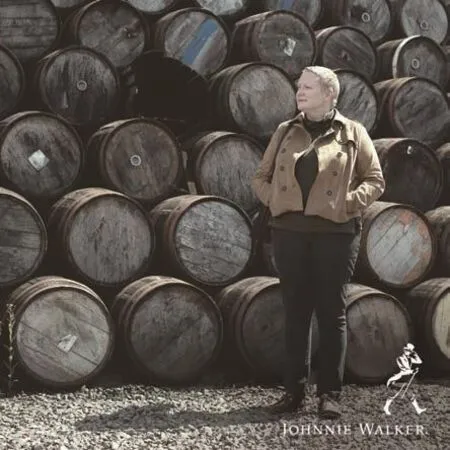
Facebook, 2017
The publications which share tips on using the product are the last type of posts which tell the brand story. They satisfy the need of the brand fans for useful information which will help them explore new consumption practices, and will enhance their experience with the brand. On the example below, the product is part of the real and the well known. The text on the cup refers to the event in which this cocktail was presented. The background also indicates that the image is taken on a crowded place. There is no striding man, no slogan because the main focus is on the existing moment—the pleasure of enjoying the here and now. The function of the text is informational, and it reveals the denotative meaning of the image.

Facebook, 2017
3.2 Jack Daniel’s Tennessee Whiskey
The story of Jack Daniel’s begins in 1864, in the United States, when Jasper Newton Daniel, more commonly known as Jack, introduces the product Old No. 7 (Jack Daniel’s,2017). Just as Johnnie Walker, the founder of Jack Daniel’s had a difficult personal story.He lost his mother when he was a child and had to leave home early in his life. He started learning how to distill whiskey when he was a boy and was determined to master the craft. Jack also had an intuition for semiotics, because he understood that he had to create unique brand elements in order to be recognized and remembered by the customers. That is why he was one of the first to stencil the product name on a unique custom-made square bottle. The brand survived both the Prohibition and the Great Depression to become an iconic brand. One of the main reasons for its success is its brand story based on heritage and tradition. Its core target audience is men 35-50 years old with higher income. They are confident, they know what they want, and they are looking for a brand that is just like them—unique, trust-worthy, and best-in-class. The brand is endorsed by famous men like Frank Sinatra, Sir Winston Churchill, and Elvis Presley, who represent the target audience’s role models. The company also engages the customers with the story by sponsoring events and communities related to traditional American values—the famous barbecue competition, the Professional Bull Riders, the Rock and Roll movement, etc.Much of the product’s success relies on an American culture which values individualism,masculinity, and the avoidance of uncertainty (Hofstede, 2010)—all of which are aligned with the Jack Daniel’s philosophy.
The company uses mainly black-and-white visuals to support its brand myth. The metaphorical meanings of the black color are power, authority, and prestige, as previously mentioned. Its most recognized symbol is its unique bottle, which has become a symbol of masculinity and social status. The core value of Jack Daniel’s is authenticity. Its functional benefits are quality, a traditional recipe, and flavor. The emotional benefits are related to heritage, success, power, and a bohemian lifestyle. The company’s communication strategy strongly relies on its brand ambassadors, who proclaim their love for the brand.The brand uses two archetypes—the creator and the outlaw. Its motivations are linked to stability and control, as it keeps making the whiskey the traditional way, as well as to risk and mastery as it develops and expands globally.
The brand communication on Facebook reflects its personality and is focused on its myth. The brand mythology is represented mainly by three types of posts, used by the company to engage the users with the brand culture. They focus on:
- the people and home of Jack Daniel’s;
- the symbolic bottle;
- product usage.
The company often shows the real people who make the product, because they build an authentic image of the brand. The goal of the company is not only to develop a Facebook brand page but to create a strong community of loyal customers. The visual example below focuses on the people as the main value of the brand which are at the core of its success. They are at the center of the image and are standing close together,thus connoting strength, unification, and togetherness. Some of them are sitting on big barrels—a symbol of tradition and heritage. They are positioned at a distance and the viewer cannot see their faces clearly, so he is detached from them. This is because their faces are not the most important thing, they represent the core brand values–traditions,trust, and commitment.

Facebook, 2017
The brand values are communicated also through the most recognized symbol—the square bottle, associated with quality proven over time. The customer not only drinks Jack Daniel’s, he experiences American history. In the example below, the meaning is conveyed by combining the strong symbol of the American flag and the text about the United States Declaration of Independence. In this context, the brand becomes a signifier of freedom and national pride. The invention of the product becomes as important as the independence of the country. There is little space between the statement about the declaration and the statement about the product, which further emphasizes that they are of equal importance. This little space conveys the same meaning as the dramatic pause used in verbal language before announcing something of great significance.

Facebook, 2017
Jack Daniel’s, just like Johnnie Walker, posts tips on product usage. They have mainly denotative meaning and are related to the consumption practices of the customers.

Facebook, 2017
4. Results
The two brand pages were closely monitored for one month (July 2017) and every post was analyzed. During this period, Johnnie Walker published 11 posts, mainly with a focus on product usage.
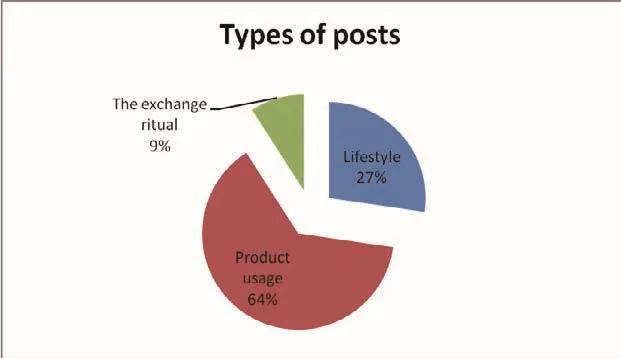
The fans of the brand engaged with it mainly with reactions (like, love, etc.) to the posts.

It is interesting to note that the posts which focused on the customers’ lifestyle inspired the most reactions and led to comments, but in terms of sharing, the exchange ritual was the most engaging content.


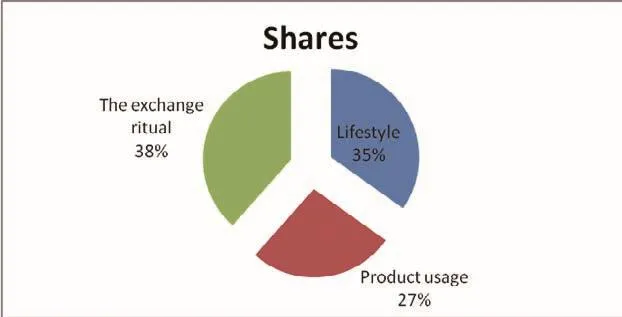
That is why we can assume that fans of the Johnnie Walker brand page are engaged with the product and are willing to identify with the brand story. Moreover, it is very positive that the highly engaging posts focused on product usage are organic and not promoted (Socialbakers, 2017), as this means that they inspire genuine interest and emotions. As a next step, the company could try to focus more on the exchange ritual and to publish content related to the possession ritual.
During the same period, Jack Daniel’s published 13 posts, of which 46% focused on the symbolic square bottle.
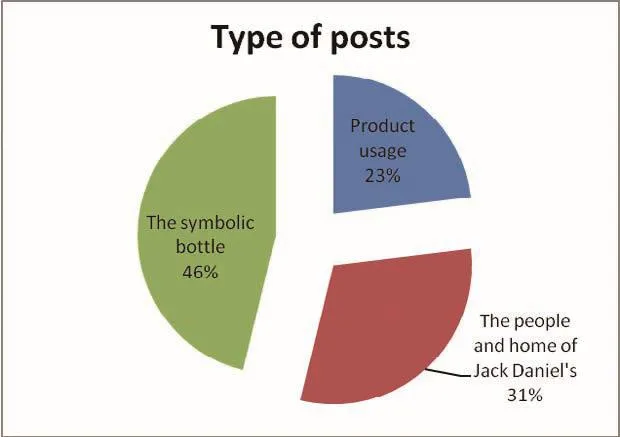
In most cases, the fans of the brand preferred to react to the posts, as compared to the other two engagement actions—sharing or commenting.

It is interesting to note that the company published posts related to product usage the least, but these are the ones that engaged the people to share and comment.
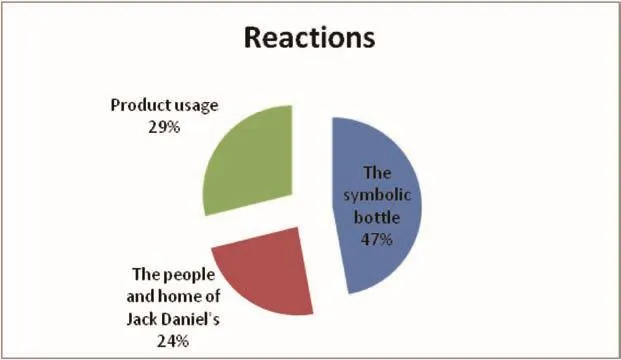

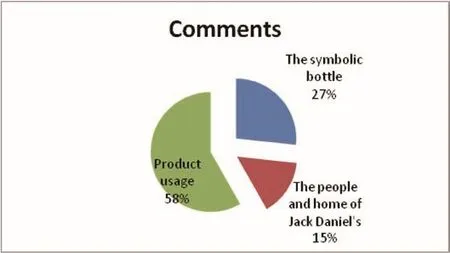
In order to increase the customers’ engagement level, the company could try to publish posts related to the exchange and possession rituals, because the monitoring showed that the brand’s fans react emotionally to product consumption.
Visual content plays an essential role for the development of the brand narrative on Facebook both for Johnnie Walker and Jack Daniel’s. The two brands are a successful example of how brand culture can be presented in a way which engages the customer and helps him build his identity by belonging to a community of people who value heritage,quality, and traditions in the case of Jack Daniel’s and quality, self-realization, and development in the case of Johnnie Walker. Both brands convey meaning using various semiotic modes—colors, text, visual elements, etc. The visual language of both brands resolves cultural contradictions: between the uncertain and challenging contemporary life,and the desire of the individual to achieve his goals and fulfill his dreams (Johnnie Walker);and between the crisis of traditions and the fast-changing environment, and the need of the individual to feel secure and part of something big and important (Jack Daniel’s). By focusing the brand rhetoric on Facebook on the brand culture, both brands create meaningful brand stories which bring value to the customers and increase their engagement.
5. Conclusion
Customer engagement is considered to be the most important metric to be measured and analyzed by the company as part of its Facebook communication strategy. At the same time,one of the main challenges is to motivate users to be active. The social network provides plentiful useful statistical data, but brands need to understand not only what customers are doing but why they are doing it. All texts in the digital space are social entities, and thus reflect the social context in which they are produced and the characteristics of the society which have created them. That is why marketers and researchers need to study the cultural and social values of the target audience. The content, which on Facebook is mainly visual,needs to reflect the culture of the brand—its values, rituals, heroes, and symbols. Both denotation and connotation add layers of meaning to the posts which have influence on customer behavior. In order to motivate higher levels of engagement, the marketing experts need to find out which elements of the brand culture appeal the most to the brand’s fans in order to align their communication strategy with the findings.
Asa Berger, A. (2012).Seeing is believing: An introduction to visual communication. New York:McGraw-Hill.
Bankov, K. (2014). Consumer rituals in Facebook. In E. Krasteva-Blagoeva (Eds.),Всичко за про∂ан: консумативната култура в България(pp. 57-77). Sofia: New Bulgarian University.
Barthes, R. (1973).Mythologies. London: Paladin.
Barthes, R. (1977).Image, music, text. London: Fontana Press.
Bauer, M. W., & Gaskell, G. (2007).Qualitative researching with text, image and sound.London:SAGE.
Bortoli, M., & Maroto, J. (2001). Colours across cultures: Translating colours in interactive marketing communications. Retrieved from https://globalpropaganda.com/articles/TranslatingColours.pdf
Brodie, R. J., Hollebeek, L. D., Jurić, B., & Ilić, A. (2011). Customer engagement.Journal of Service Research,14(3), 252-271.
Collins, R. (2005).Interaction ritual chains. New Jersey: Princeton University Press.
Color Psychology. (2017). Black color psychology and meaning. Retrieved from https://www.colorpsychology.org/black/
Duhigg, C. (2012).The power of habit.New York: Random House.
Eco, U. (1976).A theory of semiotics. Bloomington: Indiana University Press.
Epstein, E. (2014). The Johnnie Walker brand: A rich blend of design and progress. Retrieved from http://mashable.com/2014/05/02/johnnie-walker-marketing-strategy/#U3TuY5Kudsqu
Facebook Brands stats – Spirits. (2017, August 1). Retrieved from https://www.socialbakers.com/statistics/facebook/pages/total/brands/alcohol/spirits/
Foggia, P., Sansone, C., & Vento, M. (2009).Image analysis and processing—ICIAP 2009: 15th International Conference Vietri sul Mare.Heidelberg: Springer.
Fortune. (2011). Jack Daniel’s marketing magic. Retrieved from http://fortune.com/2011/12/08/jack-daniels-marketing-magic/
Gallup. (2017). Customer engagement. Retrieved from http://www.gallup.com/services/169331/customer-engagement.aspx
Godes, D., & Mayzlin, D. (2009). Firm-created word-of-mouth communication: Evidence from a field test.Marketing Science,28(4), 721-739.
Hassett, D. D., & Curwood, J. S. (2009). Theories and practices of multimodal education: The instructional dynamics of picture books and primary classrooms.The Reading Teacher,63(4),270-282.
Hofstede, G., Hofstede, G. J., & Minkov, M. (2010).Cultures and organizations: Software of the mind.New York: McGraw-Hill.
Hollis, N. (2011, April 4). The value of a social media fan. Retrieved from http://www.millwardbrown.com/global-navigation/blogs/post/mb-blog/2011/04/04/The-value-of-a-social-media-fan.aspx
INSEAD. (2006). Building the Johnnie Walker brand. Retrieved from https://amitavac.com/cms/cache/2013/08/INSEAD_Case_Amitava_Johnnie_Walker.pdf
Jack Daniel’s Tennessee Whiskey. (2017). In Facebook. Retrieved from https://www.facebook.com/jackdaniels/
Jack Daniel’s Tennessee Whiskey. (2017). Our story. Retrieved from https://www.jackdaniels.com/our-story
James, W. (1890).The principles of psychology.New York: H. Holt and Company.
Johnnie Walker. (2017). In Facebook. Retrieved from https://www.facebook.com/JohnnieWalkerUS/?id=112037388879160&brand_redir=112037388879160
Johnnie Walker. (2017). The world of Johnnie Walker. Retrieved from https://www.johnniewalker.com/en-us/the-world-of-johnnie-walker/
Kompella, K. (2014).The definitive book of branding. New Delhi: SAGE Publications India.
Kress, G., & Van Leeuwen, T. (1996).Reading images: The grammar of visual design.London:Routledge.
Kumar, A., Bezawada, R., Rishika, R., & Janakiraman, R. (2015). From social to sale: The effects of firm generated content in social media on customer behavior. Retrieved from https://www.rhsmith.umd.edu/files/Documents/Departments/Marketing/social-to-sale-jm-2016.pdf
Mark, M., & Pearson, C. (2001).The hero and the outlaw: Building extraordinary brands through the power of archetypes. New York: McGraw Hill Professional
Marrone, G. (2003).Montalbano. Affermazioni e trasformazioni di un eroe mediatico.Rome, Italy:Rai-Eri.
McCracken, G. (1986). Culture and consumption: A theoretical account of the structure and movement of the cultural meaning of consumer goods.Journal of Consumer Research,13(1),71-84.
Nöth, W. (2011).The SAGE handbook of visual research methods(Ed., E. Margolis & L. Pauwels).London: SAGE.
Oswald, L. (2015).Creating value: The theory and practice of marketing semiotics research.Oxford: Oxford University Press.
Pulizzi, J. (2012). The rise of storytelling as the new marketing. Retrieved from https://odonnetc.files.wordpress.com/2014/09/the-rise-of-storytelling-as-the-new-marketing.pdf
SAP. (2013). Social media analysis and audience engagement. Retrieved from https://www.sapvirtualagency.com/FileExplorer/Partners/SAP%20Business%20Analytics%20Solutions/Web%20Feed/Cloud%20for%20Social/MED_SID_ID0280_V01_Social_Media_Analysis.pdf
Serafini, F., & Clausen, J. (2012). Typography as semiotic resource.Journal of Visual Literacy,31(2), 1-16.
Shank, R. C. (1999).Dynamic memory revisited. Cambridge, UK: Cambridge University Press.
Socialbakers. (2017). Facebook Brands stats – Spirits. Retrieved from https://www.socialbakers.com/statistics/facebook/pages/total/brands/alcohol/spirits/
UM study. (2017). Retrieved from http://wave.umww.com/index.html
Van Leeuwen, T., & Jewitt, C. (2000).Handbook of visual analysis. London: SAGE.
Verhoef, P., Reinartz, W., & Krafft, M. (2010). Customer engagement as a new perspective in customer management.Journal of Service Research,13(3), 247-252.
Vincent, L. (2002).Legendary brands: Unleashing the power of storytelling to create a winning marketing strategy.Chicago: Dearborn Trade Pub.
(Copy editing: Curtis Harrison)
About the author
Yagodina Kartunova (yagodina4@gmail.com) is a PhD student at the New Bulgarian University. Her research is in the field of new media—how customers interact with brands in the digital space, how they use new media, how they convey meanings, and how they construct their digital reality.
 Language and Semiotic Studies2017年3期
Language and Semiotic Studies2017年3期
- Language and Semiotic Studies的其它文章
- Wilhelm II’s ‘Hun Speech’ and Its Alleged Resemiotization During World War I
- The Meaning and Madness of Money: A Semio-Ecological Analysis
- Contemporary Discriminatory Linguistic Expressions Against the Female Gender in the Igbo Language
- A Socio-Semiotic Perspective on Boko Haram Terrorism in Northern Nigeria
- Stasis Salience and the Enthymemic Thesis1
- A Century in Retrospect: Several Theoretical Problems of Russian Formalism From a Paradigm Perspective
